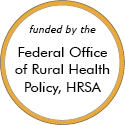Telehealth and Health Information Technology in Rural Healthcare – Models and Innovations
These stories feature model programs and successful rural projects that can serve as a source of ideas and provide lessons others have learned. Some of the projects or programs may no longer be active. Read about the criteria and evidence-base for programs included.
Evidence-Based Examples
Project ENABLE (Educate, Nurture, Advise, Before Life Ends)
Updated/reviewed May 2025
- Need: To enhance palliative care access to rural patients with serious illness, such as advanced cancer, heart failure, and COPD, and their family caregivers.
- Intervention: Project ENABLE consists of: 1) an initial in-person palliative care consultation with a specialty-trained provider and 2) a semi-structured series of weekly, phone-delivered, nurse-led or palliative care coach/navigator sessions designed to help patients and their caregivers enhance their problem-solving, symptom management, and coping skills.
- Results: Patients and caregivers report higher quality of life and lower rates of depression and (caregiver) burden.
Telepsychology-Service Delivery for Depressed Elderly Veterans
Updated/reviewed April 2025
- Need: To provide evidence-based psychotherapy for depression in elderly veterans who are unable to seek mental health treatment due to distance or stigma.
- Intervention: Telepsychology-Service Delivery for Depressed Elderly Veterans compared providing behavioral activation therapy via home-based telehealth and the same treatment delivered in a traditional office-based format.
- Results: A 2015 study and two 2016 studies show that providing treatment via home-based telehealth to elderly veterans in South Carolina resulted in the same improved health outcomes, quality of life, satisfaction with care, and cost of healthcare compared to those receiving face-to-face treatment.
UAMS IDHI High-Risk Pregnancy Program
Updated/reviewed March 2025
- Need: Arkansas had high rates of low birthweight babies, and pregnant patients in rural areas had difficulty accessing specialty obstetric care.
- Intervention: The University of Arkansas for Medical Sciences (UAMS) created the Institute for Digital Health & Innovation (IDHI) High-Risk Pregnancy Program to increase access to care for pregnant patients in an effort to improve outcomes for high-risk pregnancies.
- Results: The program has increased access to care and improved neonatal outcomes for rural Arkansas individuals through a variety of programs and has been recognized by various organizations as a model program.
Project ECHO® – Extension for Community Healthcare Outcomes
Updated/reviewed February 2024
- Need: Increase medical management knowledge for New Mexico primary care providers in order to provide care for the thousands of rural patients with hepatitis C, a chronic, complex condition that has high personal and public health costs when left untreated.
- Intervention: Project leveraging an audiovisual platform to accomplish "moving knowledge, not patients" that used a "knowledge network learning loop" of disease-specific consultants and rural healthcare teams learning from each other and learning by providing direct patient care.
- Results: In 18 months, the urban specialist appointment wait list decreased from 8 months to 2 weeks due to Hepatitis C patients receiving care from the project's participating primary care providers. Improved disease outcomes were demonstrated along with cost savings, including those associated with travel. The project model, now known as Project ECHO® – Extension for Community Healthcare Outcomes — has evolved into a telementoring model used world-wide.
Effective Examples
New Mexico Mobile Screening Program for Miners


Updated/reviewed April 2025
- Need: To increase access to medical screening for miners in New Mexico.
- Intervention: A mobile screening clinic with telemedicine capability screens miners for respiratory and other conditions.
- Results: In a survey, 92% of miners reported their care as very good, while the other 8% reported it as good. The program has expanded to three other states.
Wyoming Trauma Telehealth Treatment Clinic
Updated/reviewed April 2025
- Need: To provide psychotherapy to survivors of domestic violence and sexual assault.
- Intervention: University of Wyoming psychology doctoral students provide psychotherapy via videoconferencing to crisis center clients in two rural locations.
- Results: Clients, student therapists, and crisis center staff were satisfied with the quality of services, and clients reported reduced symptoms of depression and PTSD.
University of Vermont Medical Center's Nursing Home Telepsychiatry Service
Updated/reviewed December 2023
- Need: To improve the health status and access for rural nursing home patients in need of mental health services.
- Intervention: The University of Vermont Medical Center provides telepsychiatry care and education to nursing homes in communities that face shortages of mental health professionals.
- Results: These telepsychiatry consultations have eased the burden on nursing home residents by saving travel time, distance, and money it takes to travel to the nearest tertiary facility.
Promising Examples
TelePrEP
Updated/reviewed May 2025
- Need: To prevent new cases of HIV in rural Iowa.
- Intervention: TelePrEP provides preventive care via telehealth and prescription delivery.
- Results: Between February 2017 and August 2020, TelePrEP received 456 referrals, with 403 patients completing an initial visit.
Other Project Examples
ADPH Telehealth Program
Updated/reviewed October 2025
- Need: To increase access to healthcare throughout Alabama.
- Intervention: The Alabama Department of Public Health (ADPH) has created telehealth communications at county health departments.
- Results: ADPH telehealth services are currently available in 65 of 67 county health departments.
The Massachusetts Department of Public Health TeleSANE Center
Updated/reviewed July 2025
- Need: Clinicians in rural and underserved areas are often unprepared to provide comprehensive medical-forensic examinations for patients who present for care following a sexual assault.
- Intervention: The MDPH TeleSANE Center uses secure telehealth software to connect sexual assault nurse examiners to clinicians and patients in hospitals across Massachusetts — including five in rural counties — offering expert clinical guidance and support before, during, and after examinations.
- Results: Clinicians report that the service gives them increased confidence throughout the examination process. To date, the MDPH TeleSANE Center has assisted in the care of over 1,234 patients.
Last Reviewed: 4/12/2024

